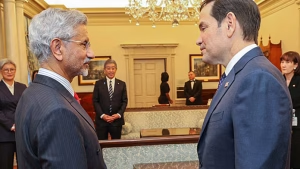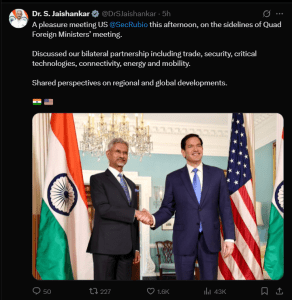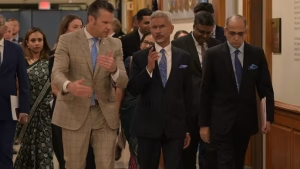Washington D.C. – External Affairs Minister S Jaishankar meets Marco Rubio in a significant diplomatic encounter that took place on the sidelines of the Quad Foreign Ministers’ Meeting in Washington. This high-level meeting between India’s top diplomat and the US Secretary of State represents a crucial moment in strengthening bilateral ties between the world’s largest and oldest democracies.
The meeting where S Jaishankar meets Marco Rubio occurred during one of the most important multilateral diplomatic gatherings in the Indo-Pacific region. The Quad Foreign Ministers’ Meeting provided an ideal platform for bilateral discussions, allowing both nations to explore new avenues of cooperation while addressing shared regional and global challenges.
During this pivotal encounter where S Jaishankar meets Marco Rubio, both leaders engaged in comprehensive discussions that covered multiple dimensions of the India-US strategic partnership. The meeting underscored the growing importance of bilateral cooperation in an increasingly complex global landscape, where both nations share common interests and values.
Comprehensive Bilateral Partnership Discussions

The substantive discussions when S Jaishankar meets Marco Rubio encompassed a wide range of critical areas that form the backbone of contemporary India-US relations. Trade emerged as a primary focus area, reflecting both nations’ commitment to expanding economic cooperation and creating new opportunities for businesses and entrepreneurs in both countries.
Also Read: S Jaishankar On India US Ties 2025: Exclusive Strategic Partnership Insights
Security cooperation dominated significant portions of the dialogue when S Jaishankar meets Marco Rubio, highlighting the strategic alignment between India and the United States on various global and regional security challenges. This security dimension of bilateral relations has become increasingly important as both nations navigate complex geopolitical situations in the Indo-Pacific region and beyond.
Critical technologies represented another major area of focus during the meeting where S Jaishankar meets Marco Rubio. Both leaders recognized the importance of collaboration in emerging technologies, including artificial intelligence, quantum computing, semiconductors, and other cutting-edge innovations that will shape the future of global economic and strategic competition.
The discussion on connectivity during the meeting when S Jaishankar meets Marco Rubio reflected both nations’ shared vision for enhanced infrastructure development and digital connectivity across the Indo-Pacific region. This includes initiatives related to digital infrastructure, transportation networks, and communication systems that facilitate greater regional integration.
Energy cooperation featured prominently in the agenda when S Jaishankar meets Marco Rubio, encompassing traditional energy partnerships as well as collaboration on renewable energy technologies, clean energy transitions, and sustainable development initiatives that align with both nations’ climate commitments.
Digital Diplomacy and Public Communication
Following the productive session where S Jaishankar meets Marco Rubio, the Indian External Affairs Minister took to social media platform X to share insights about the meeting. His post highlighted the pleasure of meeting with Secretary Rubio and provided public visibility to the diplomatic engagement.


In his social media update about the meeting where S Jaishankar meets Marco Rubio, the Minister specifically mentioned the discussion topics, stating: “A pleasure meeting US @SecRubio this afternoon, on the sidelines of Quad Foreign Ministers’ meeting. Discussed our bilateral partnership, including trade, security, critical technologies, connectivity, energy and mobility.”
The public communication following the meeting where S Jaishankar meets Marco Rubio also emphasized the exchange of perspectives on regional and global developments, indicating that both leaders addressed broader international issues beyond bilateral cooperation. This comprehensive approach reflects the maturity and depth of the India-US strategic partnership.
Multilateral Diplomatic Engagements
Beyond the primary focus on when S Jaishankar meets Marco Rubio, the External Affairs Minister engaged in multiple bilateral meetings during his Washington visit. His meeting with Australian Foreign Minister Penny Wong demonstrated the multifaceted nature of India’s diplomatic outreach during the Quad summit.
The encounter with Penny Wong, occurring alongside the meeting where S Jaishankar meets Marco Rubio, reflected the trust and comfort characterizing India’s Comprehensive Strategic Partnership with Australia. Jaishankar expressed his anticipation for welcoming the Australian Foreign Minister to India, indicating ongoing diplomatic momentum.
These multiple bilateral engagements, including when S Jaishankar meets Marco Rubio, showcase India’s commitment to strengthening partnerships with key Indo-Pacific allies and partners. The diplomatic choreography demonstrates sophisticated multilateral engagement strategies that maximize the benefits of international summits.
Defence Partnership Foundations

Prior to the significant meeting where S Jaishankar meets Marco Rubio, the External Affairs Minister held crucial discussions with US Secretary of Defence Pete Hegseth at the Pentagon. This defence-focused meeting laid important groundwork for the subsequent diplomatic engagement with Secretary Rubio.
During the Pentagon meeting that preceded when S Jaishankar meets Marco Rubio, the Indian Minister emphasized that defence partnership represents “one of the most consequential pillars” of the bilateral relationship. This characterization highlights the strategic importance of military cooperation between both nations.
The defence discussions before S Jaishankar meets Marco Rubio involved Secretary Hegseth expressing enthusiasm about growing defence partnerships, successful integration of US defence systems into India’s armed forces, and expanding industrial cooperation networks. These defence foundations provided important context for the broader diplomatic discussions.
Strategic Industrial Cooperation Framework
The defence partnership context surrounding when S Jaishankar meets Marco Rubio includes ambitious goals for expanding shared defence industrial cooperation and co-production networks. Secretary Hegseth outlined objectives for completing major pending US defence sales to India and strengthening interoperability between armed forces.
The framework discussions preceding S Jaishankar meets Marco Rubio involved plans for formally signing a new framework for US-India major defence partnership. This institutional mechanism would provide structured approaches for ongoing military cooperation and technology sharing initiatives.
These defence industrial cooperation elements, discussed before S Jaishankar meets Marco Rubio, represent significant economic opportunities for both nations while strengthening strategic partnerships. The integration of defence manufacturing and technology transfer creates long-term foundations for bilateral cooperation.
Future Diplomatic Trajectory
The successful conclusion of the meeting where S Jaishankar meets Marco Rubio establishes positive momentum for future diplomatic engagements between India and the United States. Both leaders’ commitment to comprehensive partnership across multiple domains creates strong foundations for continued cooperation.
The outcomes when S Jaishankar meets Marco Rubio will likely influence subsequent bilateral meetings, trade negotiations, technology partnerships, and security cooperation initiatives. The comprehensive nature of discussions provides roadmaps for sectoral cooperation in coming months and years.
Closing Statements
The diplomatic encounter where S Jaishankar meets Marco Rubio represents a significant milestone in India-US relations, demonstrating both nations’ commitment to comprehensive strategic partnership. The wide-ranging discussions covering trade, security, technology, connectivity, energy, and mobility reflect the maturity and depth of bilateral cooperation, setting positive trajectories for future diplomatic and economic engagement between these two major democracies.

